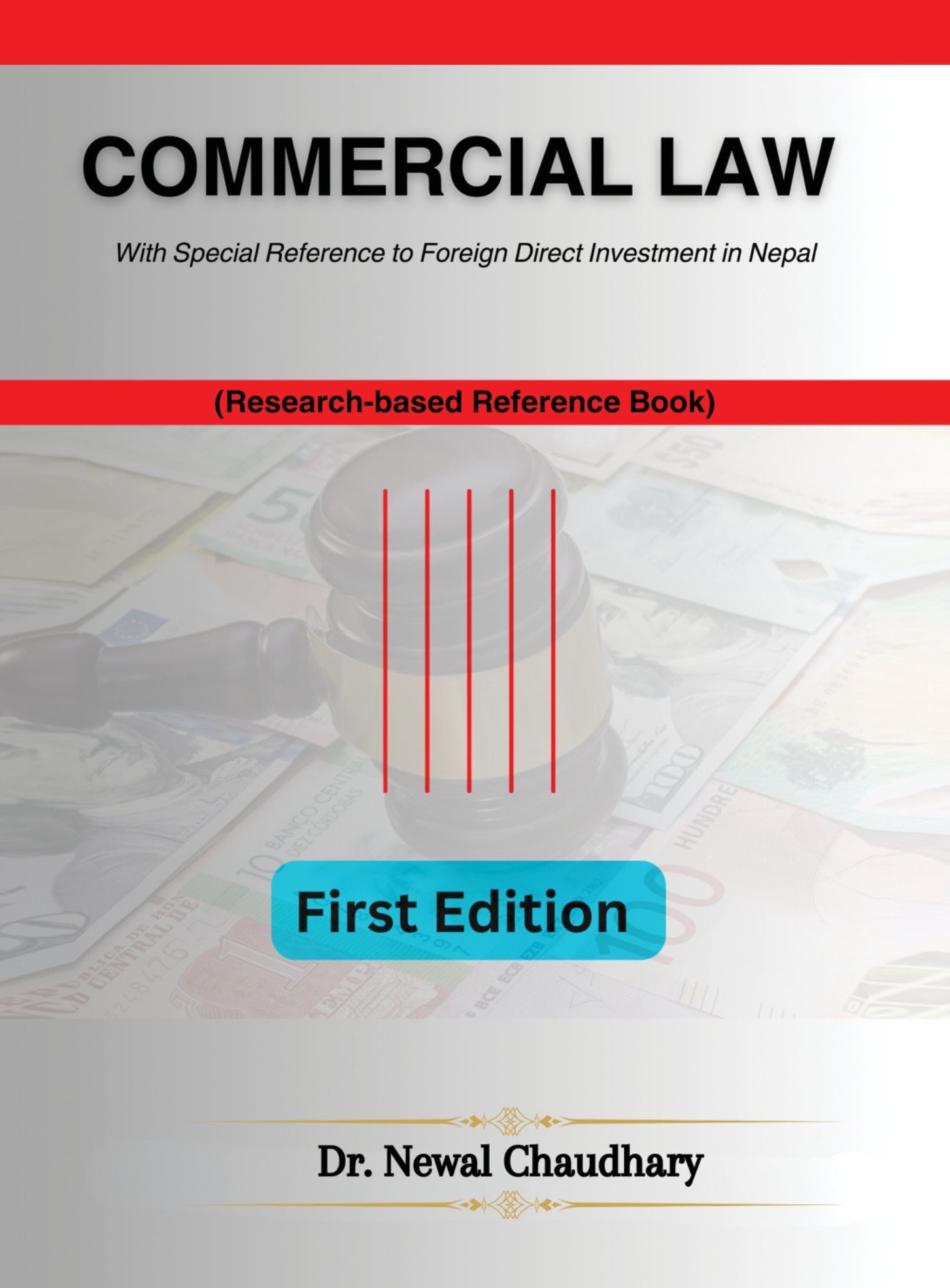Book Review of Commercial Law, with Special Reference to Foreign Direct Investment in Nepal
Research-based Reference Book by Dr.Newal Chaudhary

Foreign direct investment (FDI) has become a crucial driver of economic growth and development in emerging economies. However, attracting productive FDI aligned with national priorities remains a challenge. This comprehensive book by Dr. Newal Chaudhary undertakes a timely examination of Nepal’s FDI laws, policies and procedures from a commercial legal perspective. It provides invaluable insights into leveraging FDI for technology transfer, upgrading production capabilities and structural transformation of the Nepali economy.
Overview of the Book:
The book comprises seven chapters analyzing various aspects related to FDI and international investment law. Chapter One introduces FDI concepts, types, importance and associated risks. It explains the research objectives, methodology and theoretical foundations governing FDI. The principles, motives and evolution of global investment flows are summarized. Concepts like liberalization and privatization and their impacts on FDI are discussed.
Chapter Two traces the historical development of international investment law through academic literature. Multilateral agreements by the UN, WTO, World Bank, and regional blocs, that shaped global investment norms are examined. Bilateral investment treaties and major agreements like NAFTA are analyzed. Nepal’s own evolving legal approach to foreign investment is evaluated.
Chapter Three extensively reviews Nepal’s regulatory framework governing FDI. Constitutional provisions, legislations, policies, plans and reforms are examined. Key laws like FITTA, PPP Act, Companies Act, and their provisions are analyzed. Statistical trends in FDI inflows, sectoral distribution and country sources are summarized. Dispute resolution mechanisms and major court cases are reviewed.
Chapter Four evaluates balancing investor rights and public interest. State regulatory powers and Nepali laws related to expropriation, compensation and dispute settlement are analyzed. Global standards like fair and equitable treatment and the most favoured nation status are examined. Measures for investment promotion and screening are suggested.
Chapter Five explains the role of technology transfer and intellectual property rights for productivity and growth. Modes of technology transfer in manufacturing and services sectors are analyzed. Nepal’s IP laws are reviewed in light of international conventions.
Chapter Six empirically analyzes FDI theories, models and evidence from Nepal. Regulatory gaps and challenges are identified. Priority sectors based on competitive advantages and development needs are highlighted.
Chapter Seven summarizes the main conclusions and recommends legal, institutional and policy reforms to create an enabling environment for FDI that fosters sustainable development.
Evaluation of the Book:
Rigorous Analysis of Laws, Policies and Institutions:
A major highlight of the book is the rigorous analysis of Nepal’s FDI laws, policies and institutions. The author adopts a comparative approach to evaluate Nepal’s FDI regime relative to regional peers and international best practices. This helps identify strengths and weaknesses more objectively. The historical tracing of FDI liberalization in Nepal also provides an evolutionary perspective. The extensive literature review covering academic articles, government reports, laws, cases and treaties demonstrates the author’s industry in researching this complex subject. The analytical depth in examining statutes, bilateral investment treaties and dispute settlement mechanisms is truly commendable.
Balanced Evaluation of Investor Rights and Public Interest:
The book reflects the author’s expertise in objectively balancing investor rights and public interest. The importance of state regulatory powers to pursue legitimate socio-economic objectives is emphasized while highlighting the need to respect property rights and the rule of law. The analysis provides valuable insights into recalibrating Nepal’s model investment treaties.
Focus on Technology Transfer and Human Capital:
The pragmatic focus on intellectual property laws, technology absorption capacities and skill-building is forward-looking. FDI promotion must emphasize quality over quantity, prioritizing investments that foster positive production linkages, skill diffusion and productivity growth. Developing specialized skills and research capabilities emerges as a policy priority.
Empirical Analysis and Evidence-based Recommendations:
The empirical analysis of FDI theories, models and determinants is rigorous. Identification of gaps in policies, procedures and institutions is evidence-based. Competitive sectors suited for targeted promotion are highlighted based on economic logic, factor endowments and global trends. The suggested legal and institutional reforms are practical, keeping in mind implementation challenges in Nepal. The pragmatic recommendations cover a wide range from policy reforms to institutional coordination and human capital development. They provide a comprehensive blueprint for reforming Nepal’s FDI regime.
Conclusion
In conclusion, this contemporary reference book makes an invaluable contribution to the academic and policy discourse on leveraging FDI for Nepal’s development. It balances theoretical rigour with practical insights to benefit diverse stakeholders including academics, policymakers, investors and the general public. The extensive research, objective analysis and pragmatic recommendations are truly noteworthy. This book serves as an indispensable guide for deepening Nepal’s global integration through productive FDI aligned with national priorities.
(Bhujel is an advocate at the Supreme Court of Nepal.)



Leave Comment